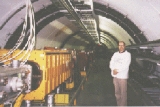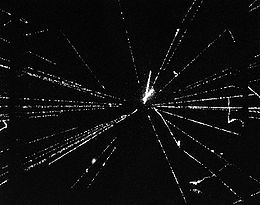
Super Proton Synchrotron
Encyclopedia
The Super Proton Synchrotron (SPS) is a particle accelerator
of the synchrotron
type at CERN
. It is housed in a circular tunnel, 6.9 kilometres (4.3 mi) in circumference, straddling the border of France
and Switzerland
near Geneva
, Switzerland. The SPS was designed by a team led by John Adams
, director-general of what was then known as Laboratory II. Originally specified as a 300 GeV
accelerator, the SPS was actually built to be capable of 400 GeV, an operating energy it achieved on the official commissioning date of 17 June 1976. However, by that time, this energy had been exceeded by Fermilab
, which reached an energy of 500 GeV on 14 May of that year.
 The SPS has been used to accelerate protons and antiproton
The SPS has been used to accelerate protons and antiproton
s, electron
s and positron
s (for use as the injector for the Large Electron–Positron Collider (LEP)), and heavy ions
. Most notably, as a proton–antiproton collider (as such it was called SpS) from 1981 to 1984, its beams provided the data for the UA1 and UA2 experiments, which resulted in the discovery of the W and Z bosons
. These discoveries and a new technique for cooling
particles lead to a Nobel Prize
for Carlo Rubbia
and Simon van der Meer
in 1984.
The SPS is now used as the final injector for high-intensity proton beams for the Large Hadron Collider
, which began preliminary operation on 10 September 2008, accelerating protons from 26 GeV to 450 GeV. Operation as injector will still allow continuation of the ongoing fixed-target research program, where the SPS is used to provide 400 GeV proton beams for a number of active fixed-target experiments, notably COMPASS
, NA48 and NA61/SHINE
. The SPS is also being used by the CNGS
experiment to produce a neutrino
stream to be detected at the Italian Gran Sasso laboratory, 730 km from CERN.
The SPS has served as a test bench for new concepts in accelerator physics. In 1999 it served as an observatory for the electron cloud phenomenon
. In 2003, SPS was the first machine where the Hamiltonian resonance driving terms were directly measured. And in 2004, experiments to cancel the detrimental effects of beam encounters (like those in the LHC) were carried out.
will require an upgrade to considerably increase its luminosity by 2015. This would require upgrades to the entire linac/pre-injector/injector chain, including the SPS.
The improvements to the SPS would most likely focus on increasing the extraction energy of the Super-SPS up to 1 TeV.
Particle accelerator
A particle accelerator is a device that uses electromagnetic fields to propel charged particles to high speeds and to contain them in well-defined beams. An ordinary CRT television set is a simple form of accelerator. There are two basic types: electrostatic and oscillating field accelerators.In...
of the synchrotron
Synchrotron
A synchrotron is a particular type of cyclic particle accelerator in which the magnetic field and the electric field are carefully synchronised with the travelling particle beam. The proton synchrotron was originally conceived by Sir Marcus Oliphant...
type at CERN
CERN
The European Organization for Nuclear Research , known as CERN , is an international organization whose purpose is to operate the world's largest particle physics laboratory, which is situated in the northwest suburbs of Geneva on the Franco–Swiss border...
. It is housed in a circular tunnel, 6.9 kilometres (4.3 mi) in circumference, straddling the border of France
France
The French Republic , The French Republic , The French Republic , (commonly known as France , is a unitary semi-presidential republic in Western Europe with several overseas territories and islands located on other continents and in the Indian, Pacific, and Atlantic oceans. Metropolitan France...
and Switzerland
Switzerland
Switzerland name of one of the Swiss cantons. ; ; ; or ), in its full name the Swiss Confederation , is a federal republic consisting of 26 cantons, with Bern as the seat of the federal authorities. The country is situated in Western Europe,Or Central Europe depending on the definition....
near Geneva
Geneva
Geneva In the national languages of Switzerland the city is known as Genf , Ginevra and Genevra is the second-most-populous city in Switzerland and is the most populous city of Romandie, the French-speaking part of Switzerland...
, Switzerland. The SPS was designed by a team led by John Adams
John Adams (physicist)
Sir John Bertram Adams KBE FRS was a British nuclear physicist and administrator.During World War II, Adams worked in the Radar laboratories of the British Ministry of Aircraft Production where he learned physics and engineering on the job. After the war he moved to Harwell and the Atomic Energy...
, director-general of what was then known as Laboratory II. Originally specified as a 300 GeV
GEV
GEV or GeV may stand for:*GeV or gigaelectronvolt, a unit of energy equal to billion electron volts*GEV or Grid Enabled Vehicle that is fully or partially powered by the electric grid, see plug-in electric vehicle...
accelerator, the SPS was actually built to be capable of 400 GeV, an operating energy it achieved on the official commissioning date of 17 June 1976. However, by that time, this energy had been exceeded by Fermilab
Fermilab
Fermi National Accelerator Laboratory , located just outside Batavia, Illinois, near Chicago, is a US Department of Energy national laboratory specializing in high-energy particle physics...
, which reached an energy of 500 GeV on 14 May of that year.
History

Antiproton
The antiproton is the antiparticle of the proton. Antiprotons are stable, but they are typically short-lived since any collision with a proton will cause both particles to be annihilated in a burst of energy....
s, electron
Electron
The electron is a subatomic particle with a negative elementary electric charge. It has no known components or substructure; in other words, it is generally thought to be an elementary particle. An electron has a mass that is approximately 1/1836 that of the proton...
s and positron
Positron
The positron or antielectron is the antiparticle or the antimatter counterpart of the electron. The positron has an electric charge of +1e, a spin of ½, and has the same mass as an electron...
s (for use as the injector for the Large Electron–Positron Collider (LEP)), and heavy ions
Quark-gluon plasma
A quark–gluon plasma or quark soup is a phase of quantum chromodynamics which exists at extremely high temperature and/or density. This phase consists of asymptotically free quarks and gluons, which are several of the basic building blocks of matter...
. Most notably, as a proton–antiproton collider (as such it was called SpS) from 1981 to 1984, its beams provided the data for the UA1 and UA2 experiments, which resulted in the discovery of the W and Z bosons
W and Z bosons
The W and Z bosons are the elementary particles that mediate the weak interaction; their symbols are , and . The W bosons have a positive and negative electric charge of 1 elementary charge respectively and are each other's antiparticle. The Z boson is electrically neutral and its own...
. These discoveries and a new technique for cooling
Stochastic cooling
Stochastic cooling is a form of particle beam cooling. It is used in some particle accelerators and storage rings to control the emittance of the particle beams in the machine. This process uses the electrical signals that the individual charged particles generate in a feedback loop to reduce the...
particles lead to a Nobel Prize
Nobel Prize
The Nobel Prizes are annual international awards bestowed by Scandinavian committees in recognition of cultural and scientific advances. The will of the Swedish chemist Alfred Nobel, the inventor of dynamite, established the prizes in 1895...
for Carlo Rubbia
Carlo Rubbia
Carlo Rubbia Knight Grand Cross is an Italian particle physicist and inventor who shared the Nobel Prize in Physics in 1984 with Simon van der Meer for work leading to the discovery of the W and Z particles at CERN.-Biography:...
and Simon van der Meer
Simon van der Meer
Simon van der Meer was a Dutch particle accelerator physicist who shared the Nobel Prize in Physics in 1984 with Carlo Rubbia for contributions to the CERN project which led to the discovery of the W and Z particles, two of the most fundamental constituents of matter.-Biography:One of four...
in 1984.
The SPS is now used as the final injector for high-intensity proton beams for the Large Hadron Collider
Large Hadron Collider
The Large Hadron Collider is the world's largest and highest-energy particle accelerator. It is expected to address some of the most fundamental questions of physics, advancing the understanding of the deepest laws of nature....
, which began preliminary operation on 10 September 2008, accelerating protons from 26 GeV to 450 GeV. Operation as injector will still allow continuation of the ongoing fixed-target research program, where the SPS is used to provide 400 GeV proton beams for a number of active fixed-target experiments, notably COMPASS
COMPASS experiment
The NA58 experiment, or COMPASS is a fixed-target particle physics experiment at the Super Proton Synchrotron, a particle accelerator at the European Organization for Nuclear Research...
, NA48 and NA61/SHINE
NA61/SHINE
NA61/SHINE is a particle physics experiment at the Super Proton Synchrotron at the European Organization for Nuclear Research...
. The SPS is also being used by the CNGS
CERN Neutrinos to Gran Sasso
The CERN Neutrinos to Gran Sasso project is a physics project of the European Organization for Nuclear Research . The aim of the project is to analyse the hypothesis of neutrino oscillation by directing a beam of neutrinos from CERN's facilities to the detector of the OPERA experiment at the Gran...
experiment to produce a neutrino
Neutrino
A neutrino is an electrically neutral, weakly interacting elementary subatomic particle with a half-integer spin, chirality and a disputed but small non-zero mass. It is able to pass through ordinary matter almost unaffected...
stream to be detected at the Italian Gran Sasso laboratory, 730 km from CERN.
The SPS has served as a test bench for new concepts in accelerator physics. In 1999 it served as an observatory for the electron cloud phenomenon
Electron-Cloud Effect
The electron-cloud effect is a phenomenon associated with particle accelerators.- Explanation :Electron clouds are created when accelerated charged particles disturb stray electrons already floating in the tube, and bounce or slingshot the electrons into the wall. These stray electrons can be...
. In 2003, SPS was the first machine where the Hamiltonian resonance driving terms were directly measured. And in 2004, experiments to cancel the detrimental effects of beam encounters (like those in the LHC) were carried out.
SPS upgrade: The Super-SPS
It has been proposed that the Large Hadron ColliderLarge Hadron Collider
The Large Hadron Collider is the world's largest and highest-energy particle accelerator. It is expected to address some of the most fundamental questions of physics, advancing the understanding of the deepest laws of nature....
will require an upgrade to considerably increase its luminosity by 2015. This would require upgrades to the entire linac/pre-injector/injector chain, including the SPS.
The improvements to the SPS would most likely focus on increasing the extraction energy of the Super-SPS up to 1 TeV.

